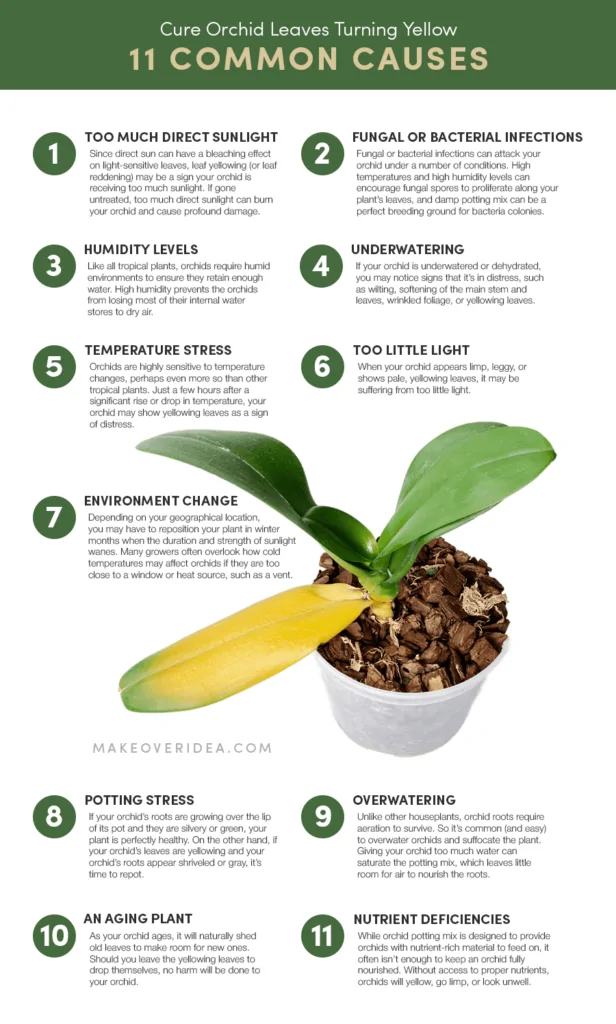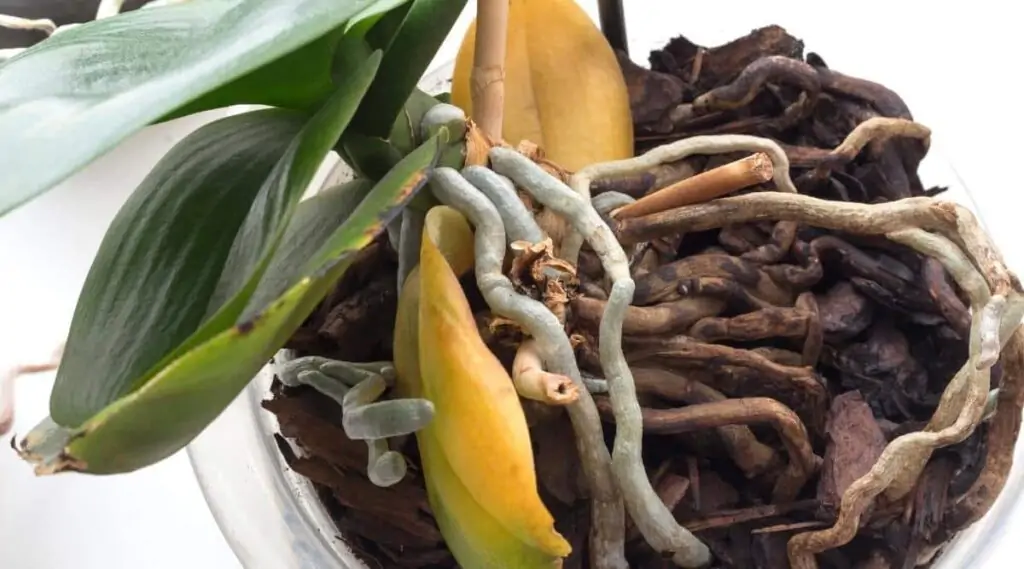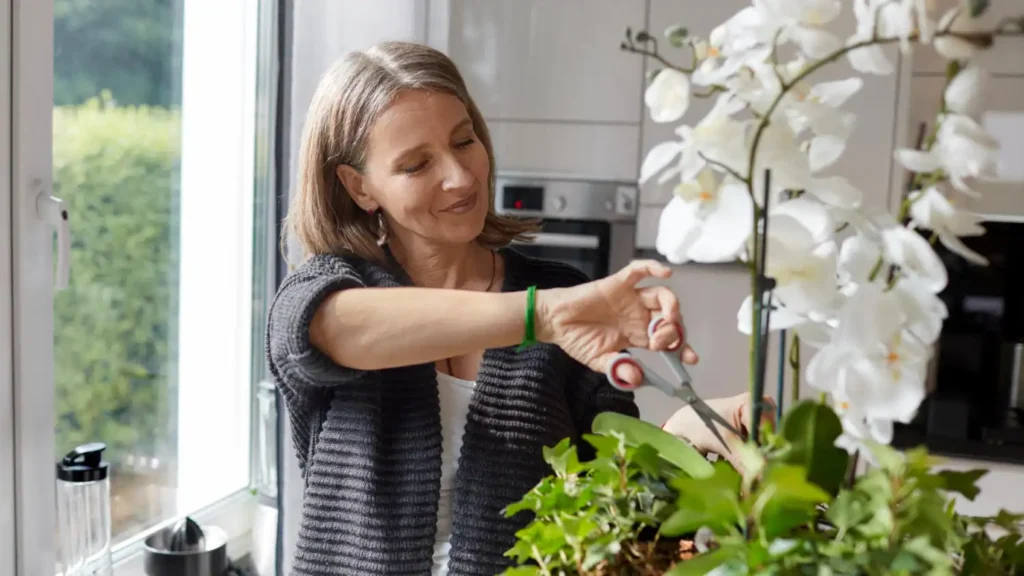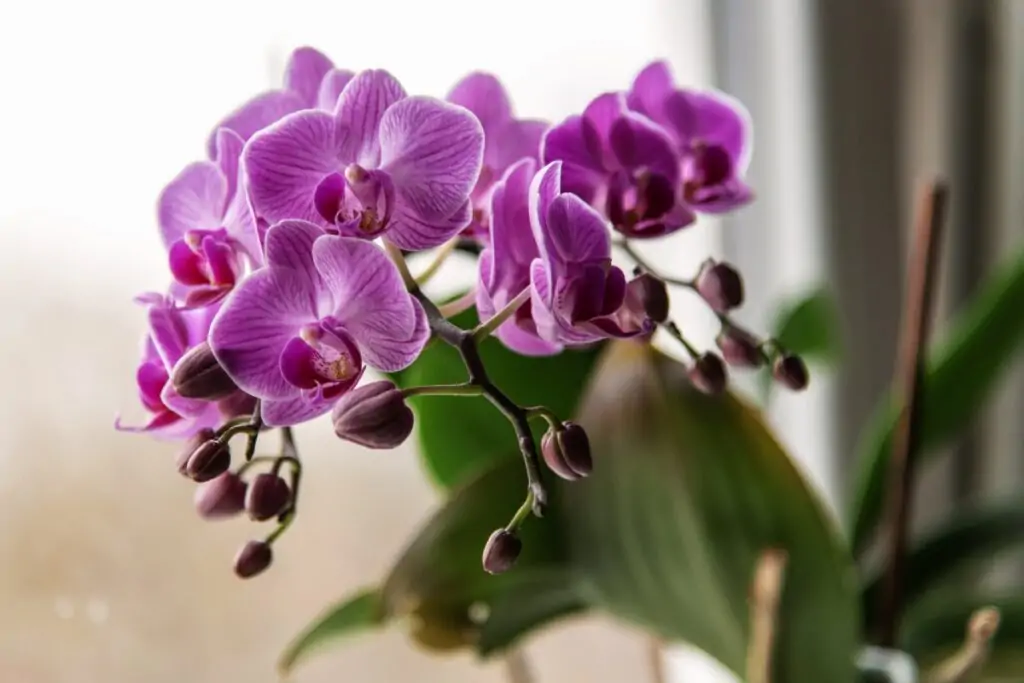Why Are the Leaves on My Orchid Turning Yellow: Answers

Why are the leaves on my orchid turning yellow? A lot of gardeners ask the same question. Let’s find the most probable answers to it and come up with effective solutions.
Common Causes of Yellow Leaves on Orchids
Orchids can be delicate, and various factors might cause their leaves to turn yellow. Let’s look at the most typical reasons and discover how to prevent or fix them.

Is It Natural Aging or Something Else?
First things first: the leaves of this plant are known for their turning yellow as they age. Older leaves near the plant’s base might yellow and eventually fall off as part of the plant’s growth cycle.
If only one or two lower leaves are affected, it’s probably nothing to fret about. But if the yellowing is more widespread, consider other explanations.
Overwatering: A Common Misstep

One of the most frequent answers to the question of why do orchid leaves turn yellow is overwatering. Orchids need a delicate balance of moisture, and too much water can lead to root rot, depriving the plant of nutrients and oxygen.
Orchid expert Susan Jones explains that “when roots are starved of oxygen, they drown and die” (source: Orchids Magazine). To prevent overwatering, let the potting medium dry a bit between the waterings.
Underwatering: Not Providing Enough
On the other hand, underwatering can also lead to the plant’s leaves turning yellow. If your flower isn’t getting enough water, its roots might struggle to deliver the necessary nutrients and hydration to the leaves. Ensure that your plant receives a consistent watering schedule tailored to its specific needs.
Excess Direct Sunlight: A Usual Suspect
Too much sunlight is another cause why orchid leaves might turn yellow, as intense light can scorch their delicate foliage. These flowers generally prefer bright, indirect light, so place your plant where it can receive the right amount of sunlight.
You might also consider buying and using the so-called horticultural grow lights (or, simply speaking, advanced fluorescent lights) that have the important advantage of emitting all wavelengths that plants can use.
Temperature Stress: Orchids’ Sensitivity
Orchids can be sensitive to temperature fluctuations, and extreme temperatures might cause their leaves to turn yellow. Keep your orchids in a stable environment, avoiding drafts or sudden temperature changes.
Remember that different orchid species have varying temperature preferences, so research your plant’s specific needs.
Humidity Levels: Finding the Sweet Spot
Orchids revel in their own personal rainforest-like atmosphere, where humidity abounds. Alas, when they don’t have enough moisture in the air, their leaves might be turning yellow.
You can use the time-tested trick of a water-filled tray with pebbles nestled beneath the pot or (better) opt for a quality humidifier. What you need is a moisture-rich 50-70% humidity level.
Do not use a mist humidifier, as your plants will be covered with a thin film of mineral deposits found in the water. Your orchids will like an evaporative humidifier better.
Overfertilization: A Fine Balance
Although orchids need fertilization to grow and bloom, excessive fertilization can cause a buildup of salts in the potting medium, leading to leaves turning yellow. Follow the recommended fertilization guidelines for your specific orchid type and adjust as needed.
Nutrient Deficiency: Keeping Orchids Well-fed
A nutrient deficiency, particularly in nitrogen or magnesium, is another reason why your plant’s leaves might be turning yellow. Ensuring a balanced fertilizer and proper watering schedule can help prevent deficiencies and maintain your orchid’s health.
Potting Stress: Orchids’ Adaptation Process

‘Why does my orchid have yellow leaves?‘ is a common question a lot of gardeners ask after having repotted an orchid. Stress caused by repotting is often enough to start the yellowing process. Repot your orchid only when needed, using a well-draining potting mix and a slightly larger pot. Allow your plant some time to adjust to its new surroundings, as it should recover from the stress.
Diseases and Pest Problems: Common Orchid Foes
Just like other flowers, orchids are not immune to diseases and pests. So, if you are wondering why is my orchid stem (or leaves) turning yellow, look for these probable causes:
- fungal leaf spot (also look for irregular spots on the leaves, use a potent fungicide),
- bacterial brown spot (also look for spots that are small and have dark-green color, remove the infected leaves as soon as possible)
- root rot (it is usually dealt with by pruning out affected roots)
- spider mites (find them on the undersides of leaves, you will need a quality pesticide)
- scale insects (look for oval to circular shells that are light yellow or dark brown in color, serious infestations will require you to use an insecticide)
- thrips (look for spots on the leaves and prematurely brown blooms, malathion, acephate, and insecticidal soap are most often recommended)
- mealybugs (dip a cotton ball in alcohol and use it to remove the bug).
How to Fix or Prevent Yellow Leaves on Orchids
Use these preventive measures, and you will never have to ask yourself why my orchids’ leaves turn yellow.
Adjusting Your Watering Routine
The first step to fixing or preventing yellow leaves on your orchids is to adjust your watering routine.
Make sure you’re not overwatering or underwatering by monitoring the moisture level in the potting mix. Water your flower when the mix is almost dry, allowing it to drain thoroughly. This helps prevent root rot and encourages healthy root growth.
Finding the Perfect Spot for Sunlight Exposure
Orchids need bright but indirect sunlight to thrive. Place your flower near a window with filtered sunlight, avoiding direct sun exposure that can cause yellowing leaves.
If you notice your orchid’s leaves turning yellow, try adjusting its location to ensure it’s getting the right amount of light.
Maintaining the Ideal Temperature and Humidity
If you want your orchids to thrive, you must be aware of their sensitivity to temperature and humidity changes. During the day, maintain a stable temperature between 65-75°F (18-24°C) and lower it to 55-65°F (13-18°C) at night.
To maintain the proper humidity levels, you can use an evaporative humidifier or place a tray with water near the flower. Keep in mind that good air circulation is also crucial in preventing diseases and pests, so make sure you provide adequate ventilation.

Fertilization Tips for Healthy Orchids
Fertilize your flower with a balanced orchid-specific fertilizer every 2-4 weeks during the growing season. Dilute the fertilizer according to the manufacturer’s instructions and avoid overfertilization. This will help provide the necessary nutrients for healthy leaves and vibrant blooms.
Proper Repotting Techniques
Repot your orchid every 2-3 years to prevent potting stress and root crowding. Use a well-draining potting mix and a slightly larger pot to encourage healthy root growth. Be gentle during the repotting process, and give your flower time to adjust to its new environment.
Common Questions About Yellow Orchid Leaves
The frequency of watering depends on your orchid’s specific needs and the environment. Generally, water your flower orchid when the potting mix is almost dry, which is typically every 7-10 days. However, this can vary depending on factors such as temperature, humidity, and the type of orchid you have.
Yes, if the cause of the yellowing is addressed, your plant may regain its health, producing new leaves and flowers. However, some issues, such as severe root rot or advanced disease, may be difficult to reverse, and the flower may not recover.
Conclusion
If you are wondering why are the leaves on my orchid turning yellow, you need to know that there are numerous causes of this condition. By reading our article, identifying the culprits, and implementing the proper solutions, you can keep your plant thriving.
Regularly monitor your orchid’s care, adjusting its watering routine, sunlight exposure, temperature, humidity, and fertilization as needed. With proper care and attention, your orchids will reward you with stunning blooms and vibrant foliage for years to come.
References:
- Rasmussen, H. N. (1995). Terrestrial orchids: from seed to mycotrophic plant. Cambridge University Press.
- Arditti, J., & Ghani, A. K. A. (2000). Tansley Review No. 110. Orchid culture. New Phytologist, 145(3), 367-389.
- Benzing, D. H. (2000). Bromeliaceae: profile of an adaptive radiation. Cambridge University Press.
- Expert opinion: Sue Bottom, the President of the St. Augustine Orchid Society, offers advice on dealing with yellow leaves on orchids.